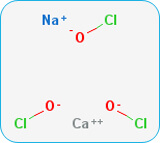FREE Standard Shipping On All Orders $100 or More!*
The Ultimate Guide to Pool Chlorine
Welcome students! Today's topic is one that is near and dear to my heart - pool chlorine! Chlorine is the most common chemical treatment used to kill bacteria and other disease causing organisms.
Chlorine has made it possible for millions of people to enjoy the benefits of swimming without concerns about pathogens that may be lurking in the water.
Not the most powerful halogen sanitizer, but it is the most common. The abundance of raw materials and ease of manufacture has made chlorine the most popular pool water treatment!
Types of Pool Chlorine
When it comes to Pool Chlorine the most common types are Calcium Hypochlorite (powder), Sodium Hypochlorite (liquid bleach) and Trichlor tablets. These types of chlorine are used for destroying contaminants in the pool water. In practice, chlorine tablets are used for everyday chlorination, because they dissolve slowly, unlike powder or liquid chlorine types, which are used for occasional super-chlorination.
Granular chlorine is used to disinfect and oxidize bacteria by killing contaminants in the pool, a process known as 'shocking the pool'. This is done by adding enough chlorine to your pool to reach a level of 10 - 30 ppm. To shock your pool, a granular or liquid is used to raise the chlorine level quickly - tablets would never dissolve fast enough.
What's the Purpose of Pool Chlorine?
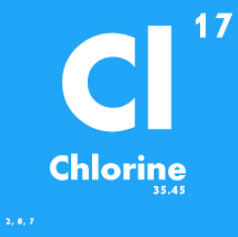
Using chlorine in your pool is one of many ways to keep the water clean, clear and safe for swimming. Not only does it kill harmful microorganisms and bacteria in the water, it also deters algae growth and helps control organic wastes like sweat, urine and body oils that end up in the water.
How Does Chlorine Work?
When chlorine is added to pool water, it breaks down into smaller chemical compounds, namely hypochlorous acid (HOCl) and hypochlorite ions (OCL-). Testing for free chlorine (FC) will tell you the parts per million (ppm) concentration of these compounds, which will also indicate the disinfecting power of the water in the pool. FC levels should be somewhere between 1.0 and 3.0 ppm at all times.
Once these these smaller compounds meet up with microorganisms in the water, they destroy the interior and exterior structure of the cell, rendering organisms like bacteria harmless. Both HOCl and OCL- aid in disinfecting the pool, but HOCl works much faster than the OCL- ions.
On the other hand, when these two compounds come in contact with organic wastes like oils, sweat or urine from swimmers, they react to form combined chlorine (CC), also called chloramines. When the CC levels in a pool get too high, a strong chlorine odor is noticed in the pool area. Chloramines can also cause skin and eye irritation for swimmers. Contrary to popular belief, the strong smell of chlorine near a pool does not indicate a sanitary pool; it actually means there are too many chloramines (and possibly un-sanitary).

If testing for total chlorine (TC) and free chlorine, you can subtract the FC reading from the TC results to find the amount of chloramines in the pool (TC - FC = CC). Ideally, the TC and FC numbers should be the same, indicating a chloramine-free pool. To boost FC levels in your pool and break down chloramines, just add more chlorine! Superchlorinate the water to give the pool a proper shock treatment.
Chlorinated Isocyanurates:
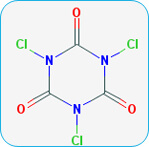
These are a group of chlorine products that contain cyanuric acid, which helps protect chlorine from degrading in sunlight. Two of the most common isocyanurates used in pools are Trichlor and Dichlor.
TriChloro-S-Triazinetrione - Cl3C3N3O3
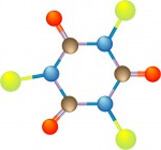
The King of chlorine products, "Trichlor" is pressed into 1" and 3" tablets, and also in stick form. Trichlor contains 52% of cyanuric acid by weight, and contributes 0.6 ppm of cyanuric acid is added to the water, for each 1.0 ppm of Free Chlorine added.
Trichlor has a relatively low pH of just under 3 - which will require the addition of pH increaser to maintain pool pH in the 7.4-7.6 range.
Trichlor has 90% available chlorine, which means that chlorine tablets are 90% as strong as chlorine gas, which has 100% available chlorine content.
Trichlor is capable of carrying other ingredients to control of algae or to improve water clarity, however this will reduce the percentage of available chlorine. For example, our Triple Action Tabs have 72% available chlorine.
Application: Trichlor tablets or sticks dissolve slowly when placed in water. 1" tablets dissolve more rapidly due to increase surface area, which is desirable in pools or spas with higher chlorine demand.
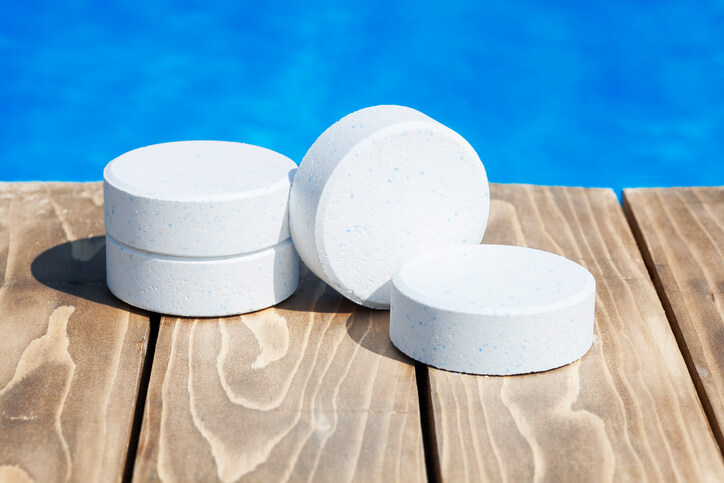
Trichlor should be added to the pool using a chlorinator. The best type is installed into the pool equipment plumbing, or a floating chlorinator can be used. One should never place chlorine tablets in the skimmer, or toss them directly into the pool.
Precautions: Chlorine tablets are highly reactive, and can explode or ignite if exposed to contaminants or other chemicals, and will release chlorine gas when moist. For this reason, chlorine tablets should be tightly sealed, and stored in a cool, dry and well ventilated area.
Chlorine gas from pool tablets will oxidize nearby metals, and should be stored where this is not a concern. Never consolidate two buckets of chlorine products, slight compositional differences can result in a reaction, producing explosion, fire or toxic fumes.
Sodium Dichloro-S-Triazinetrione - NaCl2C3N3O3
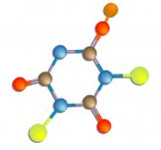
Another type of stabilized chlorine, Dichlor is a granular form of chlorine. Using Dichlor will contribute to the level of cyanuric acid in the pool. By weight, Dichlor is 57% cyanuric acid; for each ppm of chlorine added, 0.9 ppm of cyanuric acid is added to the water.
The pH level of Dichlor is nearly neutral (7.0), and won't affect the pH of the pool water noticeably, is fast dissolving and because it's sodium based, it won't contribute to calcium levels in pools.
Dichlor has an available chlorine level of 56% or 62%, depending on the formulation - anhydrous or dihydrate. Supplemental additives can be mixed with Dichlor, such as our Assure MultiShock with clarifiers and buffers, however this lowers the available chlorine percentage to 58%.
Application: Granular chlorine products are used by broadcasting the granules over the pool surface, or by diluting into a bucket of water, and pouring the mixture around the [inside] edge of the pool. Consult the label for dosage instructions prior to application.
Dichlor is used for shocking or superchlorinating, and can also be used for daily chlorination for small pools, spas and fountains.
Precautions: When broadcasting granular chlorine, one should mind the direction of wind that may blow the material in unintended ways.
Dichlor is incompatible with any other type of chlorine and is highly reactive to small amounts of dirt, dust or leaves. Mixing with any other pool chemical can cause a violent reaction, including explosion and fire.
Do not store open packages of Dichlor, which can spill or take on moisture or other contaminants. When using 1 lb. bags of Dichlor, use the entire bag at one time.
Hypochlorites:
Another group of chlorine products is known as hypochlorites, which are ions composed of oxygen and chlorine. They are made by hydrolyzing salts of sodium or calcium with chlorine, followed by rapid drying and cooling.
Sodium Hypochlorite - NaOCl
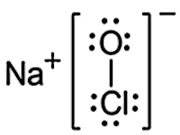
Liquid chlorine, or bleach is the most well known hypochlorite, used for a variety of cleaning and disinfecting purposes. It is not stabilized, so cyanuric acid is added to the pool separately to extend the product.
The pH level of sodium hypochlorite is very high at 13, the highest of any chlorine. This requires frequent addition of pH decreaser into pools that use liquid chlorine as the primary sanitizer.
The percentage of available chlorine is quite low for pool bleach, 12.5% is standard. Household bleach, by contrast is typically a more diluted 5 or 6% solution of the same sodium hypochlorite solution. However, due to low cost, sodium hypochlorite can be one of the cheapest chlorination methods, especially for large pools. Shelf lift is short however, liquid chlorine degrades within 6 months, losing potency over time.
Using sodium hypo can elevate TDS (total dissolved solids) levels over time, due to the high level of sodium, more than solid or granular forms of chlorine.
Application: Introducing liquid chlorine into pool water is accomplished by using a chemical metering pump; one specifically designed for the purpose, which draws chlorine from a storage container, and injects it into the pool return line.
Liquid chlorine can also be hand-fed into the pool, by pouring a bucket full directly into the pool. It dissolves instantly and leaves behind no residue.
Precautions: Storage of large quantities of sodium hypochlorite is likely safer than an equal amount of tablets, and certainly much safer than using chlorine gas. Nonetheless, caution should be taken to avoid contamination of the liquid, spills or leaks in the pumping hoses.
Like other chlorinated products, strong reactions can occur when contaminated with dirt or dust, or when mixed with other pool chemicals. Accidental mixing with acids can create an extremely toxic form of chlorine gas.
Calcium Hypochlorite - Ca(OCI)2
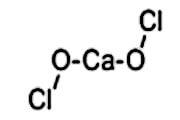
Cal Hypo, as it is colloquially known, is the most common form of granular pool shock and also the least expensive. Not stabilized, and not meant for daily chlorination. Add in the evening when the sun goes down.
The pH level of calcium hypochlorite is high at 11.7, but when used for a chlorine booster or for shock treatment, one should not see any noticeable effect on pool pH levels.
The percentage of available chlorine for Cal Hypo is standard at 65%, however some formulations such as Super Shock deliver a higher potency at 73% available.
For pools with hard water or high calcium hardness levels, keep in mind that Cal Hypo contributes to your calcium levels. For every 1 ppm of free chlorine added, Cal Hypo also adds 0.7 ppm of calcium to the pool.
Application: Like all granular pool chlorine products, it can be broadcasted or sprinkled across the surface or it can be diluted by pouring into a bucket filled with water, and added to the pool.It can also be poured directly over stained areas (plaster pools only), for quick removal of organic stains.
Consult label instructions for dosage, but the standard dose is 1 lb per 10000 gallons, which should yield 7-9 ppm of free chlorine, depending on strength used.
Precautions: Cal Hypo is one of the most dangerous pool chlorine products, to use and store. It is easily contaminated and reacts strongly to any foreign substance, yielding fumes and fires. Mixing with trichlor tablets and water creates a very strong explosion.
Salt Chlorinators

One of the most popular alternatives to chlorine tablets for sanitizing your swimming pool is a chlorine generator. With a salt water chlorine generator, you add pool salt to the water and the salt cell creates chlorine from the (slightly) salty water, through a process of molecular disassociation or hydrolysis. The amount of salt you add to your pool is roughly 20 lbs of salt per 1000 gallons of water.
The advantage of using a salt system compared to chlorine tablets is that there is less odor, and the salt will make the water much softer and provide a buffering to the pH level. But make no mistake, a saltwater pool is a chlorine pool, which is why I have added it here.
Economical Chlorine Use
Chlorine costs can be one of the larger expenses for the pool owner. With the average inground pool using 4-6 tablets per week, pool owners may be motivated to find ways to reduce their chlorine consumption. Here's some tips to lower your chlorine cost.
- Stabilize It! Using Cyanuric Acid in your inground pool protects your chlorine from the sun. Cyanuric acid is sold by the name "Conditioner" or "Stabilizer". For a residential pool, you want to keep the stabilizer in the range of 30-50 ppm. If you do not have the proper amount of stabilizer in the pool water, the chlorine can quickly degrade from UV rays, and you may have trouble keeping a chlorine residual on sunny days. Using stabilized chlorine tablets, such as In The Swim 3" tablets is also recommended, to help maintain your stabilizer levels.
 Reduce It! If you want to reduce the amount of chlorine, you will need some kind of alternative sanitizer to work with the chlorine. Some of the most popular alternative sanitizers are the Frog System, Nature 2, Ionizers and Ozonators. None of these systems will eliminate chlorine completely, but will significantly reduce the amount of chlorine you need to have in the swimming pool. Adding a supplemental sanitizer will allow you to reduce the chlorine level to 0.5 -0.8 ppm, as they kill bacteria and other organisms in the pool water, reducing the chlorine demand.
Reduce It! If you want to reduce the amount of chlorine, you will need some kind of alternative sanitizer to work with the chlorine. Some of the most popular alternative sanitizers are the Frog System, Nature 2, Ionizers and Ozonators. None of these systems will eliminate chlorine completely, but will significantly reduce the amount of chlorine you need to have in the swimming pool. Adding a supplemental sanitizer will allow you to reduce the chlorine level to 0.5 -0.8 ppm, as they kill bacteria and other organisms in the pool water, reducing the chlorine demand.- Feed It! The best way to use chlorine tablets is to use either an inline or offline chemical feeder. Place the chlorine tablets into the feeder and adjust the dial, to control the chlorine level precisely and prevent over-chlorination. By adjusting the number of tablets in the chlorine feeder, and adjusting the water flow through - you can accurately control the dissolution rate. As water becomes warmer however, and pool use increases, the chlorine demand will rise accordingly.
Shocking Your Pool Effectively
There are many different types of pool shocks available for shocking the pool - Liquid Chlorine, Calcium Hypochlorite, stabilized Sodium Di-Chlor and also a non-chlorine oxidizer called Potassium Monopersulfate.
Pre-Dissolving: With liquid shock or non-chlorine shock, you do not need to pre-dissolve, but when adding Cal Hypo and DiChlor pool shock, to a vinyl-lined pool, it is very important that you follow package instructions, and pre-dissolve the granules into a bucket of water before adding to the pool.
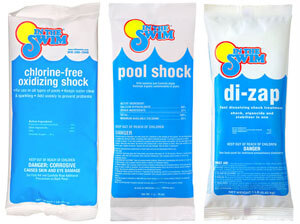
Shock your pool after a heavy bather load, to kill anything that has been able to resist your daily chlorination routine. Shocking your pool also removes chloramines, or chlorine molecules that have combined with nitrogen or ammonia. Chloramines are no longer effective sanitizers, and are responsible for red eyes, irritated skin and a strong chlorine smell. Shocking the pool is also the best treatment for the removal of algae.
In order to properly shock your pool to completely oxidize the water, it's important to reach what's called "Breakpoint Chlorination". This is the level at which everything in the pool is oxidized, which is generally 30 ppm. If you come close, but do not reach this threshold, the condition may worsen. To reach 30 ppm, this generally requires 3 lbs of shock per 10,000 gallons of pool water, otherwise known as a 'triple-shock' dosage.
Another important tip for shocking effectively is to adjust the pH to the low side of the scale, around 7.2. High pH levels render chlorine very sluggish and suppresses the activity and thus kill rates. When pH levels are over 8.0, as much as 50% of your shock can be wasted!
Pool Chlorine Safety
Here are a few pool chlorine safety tips to help you avoid a Haz-Mat situation.
- Always add chemicals directly to the pool, or to a bucket of water.
- Never mix different types of chlorine, or allow contamination from leaves or dirt.
- No smoking around pool chemicals, some types can ignite easily.
- Store your chlorine in a cool, dry location - out of the reach of children.
- When opening chlorine buckets or chlorinators, avoid breathing chlorine gas.
- Use complete bags of pool shock. Do not store opened bags of pool shock.
